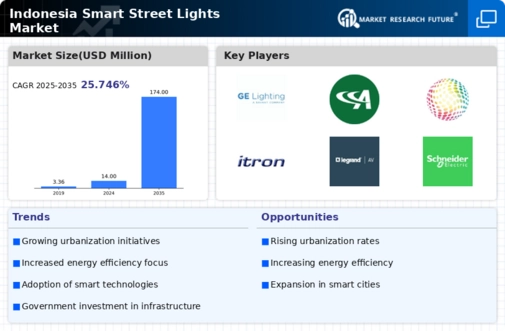Environmental Regulations and Compliance
Environmental regulations are becoming increasingly stringent in Indonesia, prompting municipalities to seek sustainable solutions. The smart street-lights market is benefiting from this trend, as these systems contribute to reduced carbon emissions and energy consumption. Compliance with national and local environmental standards is driving the adoption of smart lighting technologies. For instance, the government aims to achieve a 26% reduction in greenhouse gas emissions by 2025, which necessitates the transition to energy-efficient lighting solutions. Smart street-lights, with their ability to optimize energy use, align well with these regulatory frameworks. As cities strive to meet environmental targets, the smart street-lights market is likely to see accelerated growth.
Urbanization and Infrastructure Development
The rapid urbanization in Indonesia is a key driver for the smart street-lights market. As cities expand, the demand for efficient urban infrastructure increases. Smart street-lights, equipped with advanced technologies, can enhance public safety and improve energy management. The government has allocated approximately $1 billion for urban infrastructure projects, which includes the installation of smart lighting systems. This investment is expected to create a more sustainable urban environment, reducing energy consumption by up to 30%. The integration of smart street-lights into urban planning is likely to facilitate better traffic management and enhance the overall quality of life for residents. As urban areas continue to grow, the smart street-lights market is poised for significant expansion, driven by the need for modernized infrastructure.
Economic Growth and Investment Opportunities
The economic growth in Indonesia presents substantial investment opportunities in the smart street-lights market. With a projected GDP growth rate of around 5% annually, there is an increasing budget for infrastructure development. This economic landscape encourages both public and private sector investments in smart technologies. The smart street-lights market is expected to attract significant funding, as stakeholders recognize the long-term benefits of energy-efficient lighting solutions. Moreover, partnerships between local governments and technology providers are likely to emerge, facilitating the deployment of smart street-lights across urban areas. This economic momentum is anticipated to drive innovation and enhance the overall market landscape.
Public Safety and Crime Reduction Initiatives
Public safety concerns are increasingly influencing the smart street-lights market in Indonesia. The implementation of smart street-lights is seen as a proactive measure to enhance security in urban areas. These systems can be equipped with surveillance cameras and emergency response features, which may deter criminal activities. Recent studies indicate that cities with smart lighting solutions experience a reduction in crime rates by up to 20%. As local governments prioritize public safety, investments in smart street-lights are expected to rise. This trend not only addresses safety issues but also fosters community trust and engagement, further driving the demand for smart street-lights in urban settings.
Technological Advancements in Lighting Solutions
Technological advancements play a crucial role in the growth of the smart street-lights market. Innovations such as LED technology and smart sensors have transformed traditional lighting systems into intelligent solutions. In Indonesia, the adoption of LED street-lights has been reported to reduce energy consumption by approximately 50%, leading to substantial cost savings for municipalities. Furthermore, the integration of sensors allows for adaptive lighting, which adjusts brightness based on real-time conditions. This not only enhances safety but also contributes to energy efficiency. The continuous evolution of lighting technologies is likely to drive the smart street-lights market, as cities seek to implement cutting-edge solutions that align with their sustainability goals.





















Leave a Comment